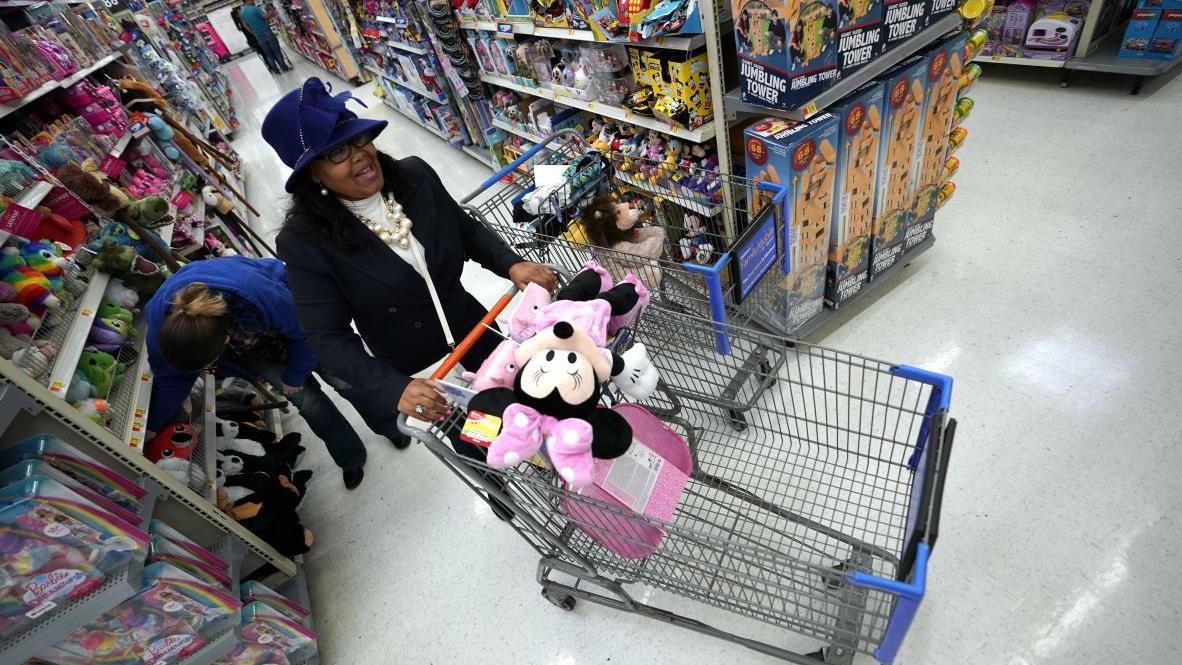Winners and losers of 2019 holiday shopping season
NEW YORK (AP) — With two weeks until the official start of the holiday shopping season, the nation’s retailers are gearing up for what should be another brutally competitive shopping period.
The good news? Many retail CEOs say the U.S. consumer is financially healthy given the economy remains strong and the unemployment rate is near a 50-year low. But keeping up with shoppers’ behavior has been challenging for retailers, whether it’s the yearslong shift to shopping online or the more recent desire to rent or buy second-hand clothes and other items. Retailers also face increasing pressure from online leader Amazon, which has been raising the stakes in speedier shipping.
Here are some key trends and milestones to watch:
US ONLINE SPENDING FOR 2019 HOLIDAY SEASON TO REACH RECORD HIGHS: WHAT TO KNOW
THE FORECASTS

Photo shoppers browse the food-themed decorations in the Holiday Lane section at the Macy's flagship store, in New York. (AP Photo/Richard Drew)
The National Retail Federation, the nation’s largest retail trade group, forecasts that holiday sales will rise between 3.8% and 4.2% even as the ongoing U.S.-China trade war creates some uncertainty around pricing and supplies. Sales growth at the top of that range would double the disappointing 2.1% growth seen in November and December of 2018, which fell well short of the group’s prediction of 4.3 % and 4.8 %. Last year’s holiday sales were hurt by turmoil over President Donald Trump’s trade policy regarding China and a delay in data collection by nearly a month that NRF said made the data slightly less reliable. The group expects online and other non-store sales, which are included in the total, to increase between 11% and 14%, for the holiday 2019 period. The NRF forecast, which considers economic indicators such as consumer credit, disposable personal income and monthly retail sales, excludes sales from autos, gas, and restaurants. Other groups are more optimistic: Deloitte expects holiday retail sales to rise 4.5 % to 5%, and AlixPartners predicts growth of 4.4% to 5.3%.
WHAT MAKES THIS HOLIDAY SEASON DIFFERENT?
For one, this holiday season is the shortest since 2013 and six days shorter than the 2018 season because Thanksgiving falls on Nov. 28. Retailers say such a compressed season will put more pressure on them to make every day count. Walmart and others are trying to get into the minds of shoppers sooner, with earlier deals and advertising. This season is also different because more retailers like Walmart and Amazon are offering next-day delivery, raising the pressure for them to satisfy shoppers without any glitches. Amazon has said that more than 10 million items now qualify for next-day delivery for its Prime members, who pay $119 a year.
CLICK HERE TO READ MORE ON FOX BUSINESS
KEY MILESTONES FOR DATA

Shoppers browse the Holiday Lane section at the Macy's flagship store, in New York. (AP Photo/Richard Drew)
Analysts will be sifting through key data throughout the season. The first big milestone comes after the five-day Thanksgiving weekend, when the NRF releases the results of its survey that offers insights into shoppers’ intentions on that first big weekend of the holiday season. The weekend, which includes Cyber Monday, isn’t necessarily a good predictor of how the whole season will go, but it can reveal some trends.
MasterCard SpendingPulse, which tracks all types of payment including cash and check, historically offers holiday sales insights and trends during key periods including right after the Thanksgiving weekend and after Christmas. Adobe Analytics offers online sales updates including for Cyber Monday — Dec. 2 this year — and it typically does a recap of the holiday season in mid-January. Shipping company FedEx might comment on the holiday season when it releases fiscal second-quarter earnings on Dec. 17.
MILLENNIALS ARE MOST ACCEPTING OF GOING INTO HOLIDAY DEBT
It won’t be known how overall November and December holiday sales fared until the government releases its December retail sales figures in mid-January. The NRF extrapolates that data and comes out with the two-month holiday sales results. Meanwhile, retailers will be releasing fiscal fourth-quarter results in February — that will offer more color on the holiday season including how much discounting affected profits.
WINNERS AND LOSERS

Shoppers browse the Holiday Lane section at the Macy's flagship store, in New York. (AP Photo/Richard Drew)
Heading into the official start of the holiday season, big discounters like Target and Walmart and others that have consistently won over shoppers with their low prices and expedited shipping should be among the clear winners. Off-price discounters like T.J. Maxx, which have fared well by offering customers a treasure hunt experience should also do well. Meanwhile, it’s a mixed bag regarding department stores. Macy’s is touting its interactive experience called Story in 36 stores, while Kohl’s is offering a slew of exclusive partnerships like the Elizabeth and James brand founded by Mary-Kate and Ashley Olsen.
HOLIDAY RETAIL SALES COULD REACH $1 TRILLION THIS SEASON: FORMER TOYS R US CEO
But J.C Penney’s is expected to struggle as it has yet to figure out a reinvention strategy that revives sales. And investors will be watching Sears, which continues to close stores. Many mall-based clothing chains like Gap are also expected to continue to flounder as they’ve had a hard time differentiating themselves from their rivals.
Given this climate, brands like Banana Republic and Urban Outfitters are launching for the first time rental subscription services. Meanwhile, Macy’s and J.C. Penney’s have teamed up with online resale site ThredUP to carve out dedicated areas in select stores to sell used clothes. Investors will be watching to see how these initiatives fare.
